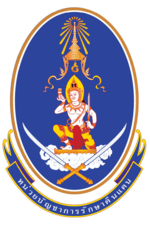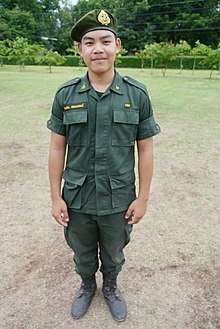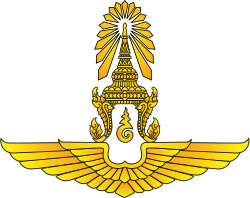Territorial Defense Student
| Territorial defense students นักศึกษาวิชาทหาร (RTGS: Nak suek sa wicha thahan) | |
|---|---|
 Official seal of the Territorial Defense Command | |
| Active | 1948 - Present |
| Country | Thailand |
| Branch | Royal Thai Army |
| Type | Military reserve force |
| Part of | Territorial Defense Command |
| Garrison/HQ | Reserve Affairs Center, Bangkok (13°44'46"N 100°29'42"E) |
| Nickname(s) | Rodo (ร.ด.) |
| Motto(s) |
"แม้หวังตั้งสงบ จงเตรียมรบให้พร้อมสรรพ์ ศัตรูกล้ามาประจัน จะอาจสู้ริปูสลาย" ("Hope for peace, so be prepared for fight. No foe is more fearless than us.") |
| Colors | Khaki-Green |
| March | Territorial Defence Students' march (เราเหล่านักศึกษาวิชาทหาร) |
| Anniversaries | 8 December |
| Engagements | Battle of Tha Nang Sang bridge |
| Commanders | |
| Current commander |
Lieutenant General Prakarn Padavanija (พลโท ปราการ ปทะวานิช) |
| Notable commanders |
General Admiral Air-chief Marshal Luang Suddhisanranakorn (Suddhi Sukawathi) พลเอก พลเรือเอก พลอากาศเอก หลวงสุทธิสารรณกร (สุทธิ สุขะวาที) Lieutenant General Khun Sinsornchai (พลโท ขุนศิลป์ศรชัย) General Vichit Sriprasert (พลเอก วิชิต ศรีประเสริฐ) General Yodsanan Raicharoen (พลเอก ยศนันท์ หร่ายเจริญ) General Weerachai Inthusophon (พลเอก วีรชัย อินทุโศภน) |
| Insignia | |
| Regimental Insignia | Crossed swords under the Great Crown of Victory |
Territorial defense students (Thai: นักศึกษาวิชาทหาร; RTGS: nak sueksa wicha thahan) are a military youth organization in Thailand under control of the Royal Thai Army, and recently the Royal Thai Navy and Royal Thai Air Force.
History
.svg.png)
Prior to World War II the Yuwachon Thahan (or "junior soldiers", Thai: ยุวชนทหาร) were established in 1934 by Field Marshal Luang Pibulsonggram. At the beginning of World War II junior soldiers were sent to fight troops of the Japanese Empire that invaded southern Thailand on 8 December 1941.
At the end of the war the junior soldiers were disbanded, but Lieutenant General Luang Chatnakrop (พล.ท. หลวงชาตินักรบ) created the territorial defense students to replace them in 1948. Today most students who participate in the reserve do so to avoid the chances of being drafted into the full-fledged military for about three years. Because of this, the requirements for admission have been made more stringent.
There were also rumors of a potential change of policy, wherein Grade-3 students would be required to serve, but for only 3–6 months or a year.
Requirements
- Thai nationality
- Age younger than 22 years
- Approval of parents or guardians
- A grade-point average above 2.50 or a certificate of passing senior scout
- A certificate of health. People with disabilities, fatal sickness, disease, or eye problems such as color blindness are not allowed.
- Body mass index of less than 30 (obesity)
- Must have appropriate body height and size corresponding to age
- Passing a fitness test of an 800-meter run in 3 minutes 15 seconds, 34 sit-ups in two minutes, and 22 push-ups in two minutes. Female applicants have more relaxed requirements.
- Students are required to cut their hair so that the white of their scalp is visible on 3-sides, and a small patch of hair is visible on the top of the head.
Applicants who do not meet fitness test requirements are ranked by their scores. Applicants with higher scores have priority. Applicants who do not meet other criteria may be accepted in a case-by-case basis. If extra funding is available, more applicants are accepted.
After the tests are completed, those accepted are awarded a green beret.
Study
Royal Thai Army
Territorial Defense students have to study 80 hours per year and attend a period of field training, but commonly only for Grade 2 through Grade 5 students. The students must have a perfect presence for training course and are not allowed to skip any exams. At the end of every semester territorial defense students have to pass an exam to continue their study at the next grade.
Territorial Defense students have to pass:
- Marksmanship test using a rifle, where the test parameters are related to grade
- Written test of 100 multiple-choice questions (only common for Grade 3 through Grade 5 students)
- Physical test covering procedures, use of tools, and discipline learned during the year
Territorial Defense students have five grades:
- Students who complete Grade 1 are equivalent to private first class and will halve their service period as a conscript.
- Students who complete Grade 2 are equivalent to corporal and their service period will be only a quarter that of a non-military student.
- Students who complete Grade 3 may request permission to use the title sergeant, and are exempt from conscription.
- Students who complete Grade 4 are equivalent to Master sergeant
- Students who complete Grade 5 and their bachelors degree are commissioned as acting second lieutenants. Also, at graduation from their university, they are allowed to dress in white officer's uniform and wear a sword.
Field training lengths (dependent on grade and gender of the student):
- Grade 2; male: at least three days
- Grade 3; male: at least five days
- Grade 4-5; male: at least seven days
- Grade 2-3; female: at least three days
- Grade 4-5; female: at least five days
Field training occurs at Khao Chon Kai Training Camp for Grade 2 and 3 students studying at a territorial defense training centre within the Bangkok Metropolitan Area or the central region of Thailand, and all Grade 4 and 5 students from throughout the country. For Grade 2 and 3 students studying in other areas, the field training occurs at the respective training centre's designated area.
Royal Thai Navy
Territorial Defense training was introduced in 2009 for the Royal Thai Navy, only for students and youth living nearby the Sattahip Naval Base in Chonburi Province. About 90 students are accepted each year and training is done at the Sattahip Naval Base. Upon reaching Grade 3, students will then further separate into one of the three smaller units operated separately by:
- The Royal Thai Marine Corps
- Coastal Defense Command
- Strategic Naval Command
Royal Thai Air Force
Territorial Defense training was introduced in 2006 and available until Grade 5 by 2010 for the Royal Thai Air Force, only for students studying in polytechnic colleges within the locale of the Don Muang Royal Thai Air Force Base, Bangkok. The study will involve only about the mechanical side of the air force only.
Small arms
| Name | Type | Caliber | Origin | Notes |
|---|---|---|---|---|
| Type 86 | Semi-automatic pistol | .45 ACP | M1911A1 pistols produced under license. | |
| Type 11 | Assault rifle | 5.56mm | Thai license produced version of the Heckler & Koch HK33. Used by territorial defence students. | |
| M16A1/A2/A4 | Assault rifle | 5.56mm | Standard infantry rifle. Aging M16A1 will be replaced by IMI Tavor TAR-21 and M16A4. | |
| M4A1 Carbine | Assault rifle | 5.56mm | Used by special forces. Some were equipped with SOPMOD kit. | |
| M1 Garand | Semi-automatic rifle | .30-06 | Locally known as the Type 88 self-loading rifle (ปลยบ.88). Used by Royal Guards and by territorial defence students as a non-firing training rifle. | |
| M1/M2 Carbine | Semi-automatic rifle | .30 | Locally known as the Type 87 carbine (ปสบ. 87) Used by territorial defence students as a non-firing training rifle. | |
| Type 66 | Bolt-action rifle | 6.5x50mm Arisaka | Some document claim that it is Arisaka produced under license but another document claim that it origin from Switzerland. Locally known as the Type 66 self-loading rifle (ปลยบ.66).Used by territorial defence students as a non-firing training rifle | |
| Springfield | Bolt-action rifle | .30-06 Springfield | Used in small numbers and only some boot camp. | |
| FN MINIMI | Light machine gun | 5.56mm | ||
| M60 machine gun | General purpose machine gun | 7.62mm | Former main GPMG being replaced by FN MAG 58 | |
| FN M2HB | Heavy machine gun | 12.7mm | ||
| M203 | Underbarrel Grenade launcher | |||
| M79 | Single-shot grenade launcher | |||
| M72 LAW | Shoulder-fired missile | |||
| RPG-2 | Rocket-propelled grenade | |||
| RPG-7 | Rocket-propelled grenade |
Uniform and insignia

Army territorial defense students wear a khaki-green uniform and beret with the Army Reserve Command Insignia (Crossed swords under The Great Crown of Victory) on their collar, beret, and belt. Territorial defense students distinguish their school and province by the school's coat of arms on the right shoulder, and provincial badge on left breast. The name badge is sewn on the right chest.
Training Years and Rankings
Each student's rankings and training year can be distinguished by Thai Numerals ranging from 1 to 5 on the left collar on a black background. These rankings are denoted by the number's background color, which are modified from the ordinary black background of the normal student.
- "Green" represents Squad Leader (no armband)
- "Red" represents Platoon Leader
- "Light Blue" represents Company Leader.
These rankings notations can further be denoted by an armband of the corresponding color. And in addition to this, there are superior ranks specifically identified only through these armbands and usually assigned only during field training.
- "Brown" represents Battalion Vice-Leader
- "Dark Blue" represents Battalion Leader
Student's command chain may be as high as a regiment, but the color of armband representing this ranking is ambiguous usually denoted with Light Blue like Company Leader, and specifically stated "Regiment Leader".
Special training
About 120 fourth grade territorial defence students who pass the physical test are allowed to enter the parasail training course. Requirements are, for males, 15 pull-ups with no time limit, 47 push-ups in two minutes, 65 sit-ups in two minutes, and a one mile run in eight minutes. Female applicants have more relaxed requirements.
Battle of Tha Nang Sang Bridge
.jpg)
On the first day of the Japanese invasion of Southeast Asia (8 December 1941), the Japanese Army sent troops to many parts of Chumphon Province. At Ma Hat Bay (อ่าวมะหาด), the Japanese forces landed on beaches stretching from Ban Pak Nam Chumphon (บ้านปากน้ำชุมพร) to Ban Kho Son (บ้านคอสน). The 38th Infantry Battalion of the Royal Thai Army, about 17 km away, was too far away to intercept the initial invaders in time. As a result, roughly 100 of the reserve students and the local police force had to hold the numerically superior Japanese army at bay from positions on the west side of Tha Nang Sang Bridge until the 38th Infantry could arrive.
The force of reserve students and policemen sent their 1st Light Machine Gun Company across the bridge at 08:00. They then went through Wat Tha Yang Tai to block any Japanese reinforcements. The commander of 38th Infantry wished to send his 4th Heavy Machine Gun Company across the bridge to protect the government buildings on the Tha Taphoa River, but the Japanese troops fired upon the Thai defenders from the other side of the river. The reserve students, under command of Captain Thawin Niyomsen (ร้อยเอกถวิล นิยมเสน), commander of the Chumphon Junior Soldiers Training Centre, charged cross the bridge to seize strategic points on the east side. Under heavy Japanese fire, Captain Thawin was killed when he attempted to find a new position for his light machine gun squad. The remaining students, now headed by Sergeant Samran Khuanphan (สิบเอกสำราญ ควรพันธ์) from the training centre, were able to maintain their position, and waited for friendly reinforcements. Thailand, however, surrendered to Japan before noon.[1]

